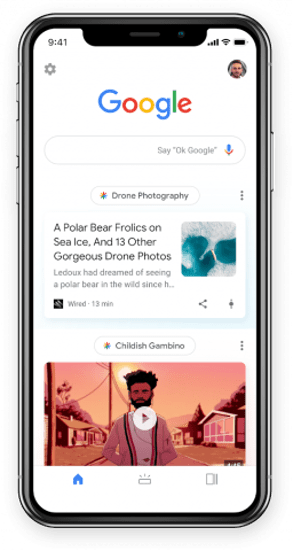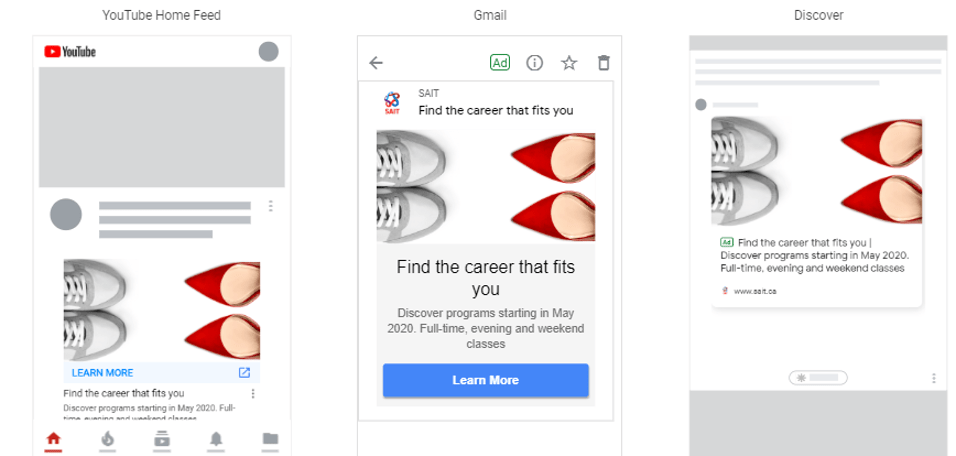Exploring New Ad Formats – Google Discovery Ad Campaigns
Google’s reach into the apps we use is far-reaching: Gmail, YouTube, Maps, Chrome and the Google app itself. With so much real estate for ad inventory, it’s not surprising that there are continually new ad placements and formats being released across their network. As a Google Premier Partner, we get the chance to test new formats and features while they’re in beta. Today we are covering one of the newest ad formats – Google Discovery ads. What are they, and should you consider using them?

What are Discovery Campaigns?
Discovery ad campaigns enable advertisers to deliver rich, personalized ad experiences to people who are ready to discover and engage with their brands. They use a native-like ad format that is mobile-first. Based on what we’ve tested so far, 98% of impressions are coming from mobile devices. Ads appear on feed-based content on YouTube Home and Watch Next feeds, Gmail, and Google Discover.
Discovery ads were released in beta in November 2019, so they’re still considered a fairly new ad format. Google recently announced that Discovery Campaigns are now out of beta and available for use on all accounts.
Hold On, What’s Google Discover?
To back up a bit, it’s possible you haven’t heard of Google Discover before. Google Discover is the new name for the Google Feed which appears in the Google app (available on Androids and iPhones). Google has historically been known for answering questions after people asked them, but Google Discover turns this around – the aim behind the new Feed is to answer questions before you ask them, which is done via AI. Based on the content you engage with on Google Discover, the algorithm will learn your interests and start showing more relevant content and articles to you. This is the new home for most Google Discovery ads, perfect for a native format.

This is what the Google Discover feed looks like above. All of the content below the search bar is based on Google’s AI and the content they think you’ll be interested in seeing based on what you’ve engaged with already.
How do Google Discovery Ads Work?
Discovery campaigns feature two ad types:
- Responsive single image ad – You choose the headlines, descriptions, and images. Then, Google uses machine learning to automate serving the best combinations of these elements.
- Carousel ad – Unique to Discovery campaigns, this is a swipeable format that allows you to add multiple products in one ad.
Discovery ads can appear on YouTube, Gmail, and Google Discover. This is what Google Discovery ads look like across these platforms on mobile:

Targeting for Google Discovery ads is just like regular Google Display campaigns. They can be targeted based on demographics and interests, including affinity audiences, in-market audiences, and remarketing options.
Based on what we’ve seen so far, this campaign type tends to have a lower cost-per-click and higher click-through rate than regular Google Display campaigns. However, as one of the Google automated campaign options it has some limitations to be aware of if you’re thinking of trying this out:
- No frequency capping – you can’t limit the number of times a user will see your ad
- No ad rotation – you can’t test multiple ad creatives against each other which puts some limitations on AB testing
- No transparency on placements – it’s not clear where your ads showed, so you don’t know how YouTube, Gmail or Discovery performed individually, you’re only able to see a summary of all the placements
When is it Best to use Google Discovery Campaigns?
Discovery ads are hybrid formats that can work well for both awareness and conversion based campaigns. However, since it only works on behaviour-based data, you need to have a tracked action on your website connected to the campaign. So to run an awareness campaign, some softer conversion points have to be set up for optimization purposes. It could be as simple as spending at least a certain amount of time on a landing page, or scroll tracking for users who read more than a certain percentage of the page. A flow of conversion data (even for softer engagement points) into the campaign is necessary to help ensure it’s being optimized appropriately.
Overall, this campaign type gives a great opportunity to expand reach beyond Google Display Network and catch potential customers when they are actively discovering their favourite content with an engaging ad.
Are you interested in learning more about Google Discovery campaigns or are you looking for support on your own Google campaigns? Reach out to us today and let’s chat!
